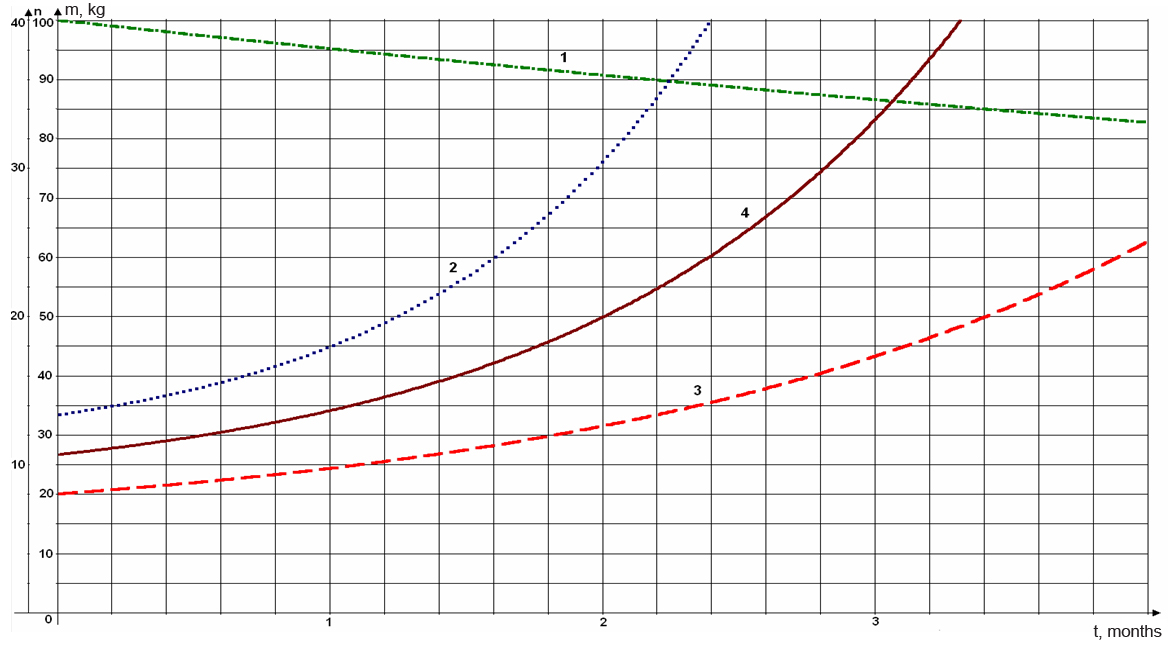THE EFFECT OF INTERVAL WORKOUT ON ENHANCEMENT OF BODY ENDURANCE AND TRAINING OF MAIN MUSCLE GROUPS
Фотографии:
ˑ:
V.V. Gil'. Russian state technological university named after K.E. Tsiolkovsky (MATI)
M.V. Sergeeva
Training complex "Staraya ploschad'", Moscow
Key words: interval workout, steady workout, strenuous load.
Recently traditional fitness and aerobics classes (including strengthening exercises) have gone out of date. Moreover, there is a danger in such exercises. Sooner or later one will want to give up these exercises since, firstly, they are boring and, secondly, the result is too insufficient compared to man-hours. That’s why interval workout is getting more popular [1].
The feature of this method is in the use of all types of physical loading at interval workouts (run, cycling, swimming, aerobics and even dances). As opposed to standard sport classes (frequently steady due to the lack of interval division by the level of loading on the body) the core of the interval workout consists in the alternation of high and low intensity intervals of physical loading [5, 2, 3]. These intervals can be changed by various means: time spans, distance or pulse rate. Nowadays interval workout is gaining its popularity due to numerous advantages compared to steady workouts [1-5]:
- less time spent for trainings;
- significant increase of body endurance to strength and aerobic exercises [1];
- strengthening of cardiovascular system;
- rapid development of muscles trained;
- calories burnt even long time after the interval workout is finished (so called inertia moment).
The purpose of the study was to estimate the effect of interval training on the increase of body endurance and strengthening of basic muscle groups.
Materials and methods. The group of 10 physically healthy men at the age of 25 to 30 with the initial fitness level was selected.
The goals of the studies were as follows: to make athletes lose their weight, to strengthen the main muscle groups and to enhance body endurance for long-term physical loadings. Interval training was chosen as a methodology of training.
According to the studies, interval training can be used both for beginning low-endurance athletes striving to improve their physical shape and for professional athletes (the latter use interval trainings in the pre-season) [2]. First of all, the plan of interval training depends on the athlete’s fitness level: number of repetitions, time of each repetition, etc. [5, 2].
The plan with shorter intervals of strenuous loading and longer periods of recovery (with further duration changes of stated periods) was chosen for beginners. Trainings were held three times a week and the interval training exercise course lasted 4 months.
The stated purpose of the study was achieved by designing a training algorithm with the use of interval trainings, presented in Table 1.
Each training included a set of physical exercises facilitating in losing weight and increasing of endurance of the subjects’ body. Apparently, prior to loadings the body is to be ready for exercises of different types.
A warm-up before loading rises the body temperature from 35 to 38 degrees and makes muscle tissues more flexible, preventing their sprains and disruptions and allowing metabolic reactions going at maximum rates. Nutrients are distributed in the body via cardiopalmus almost 20 times faster and the muscle blood consumption increases fivefold. All this is necessary when the body is being trained for a long-term and extremely strenuous loading.
Warm-up anticipates any training and is meant for general warming of the body. Running in place, jumps of different types (sideways, forward-back, etc.) and light articular exercises (including wrist, knee, elbow, shoulder, hip and ankle joint warm-up) were chosen for the warm-up. The duration of warm-up exercises was chosen to train the body for strenuous aerobic workout.
Aerobic workout (“aerobic” literally means “absorbing air” – here oxygen is useful for cellular nourishing) is a complex of low or average intensity exercises for development of cardiovascular system. The aerobic workout is characterized by the increased pulse rate up to 90 percent of its maximum and by long duration (constant muscle work lasts more than 5 minutes), with the exercises being dynamic and repetitive. Any aerobic workout has the following characteristics:
- exercises are performed for all body muscles;
- exercises are intended to lose weight;
- aerobic loading can be steady or alternating;
- exercises are meant for all fitness levels: from beginner to advanced.
Such exercises as running (in place, lifting hips high, with a curl, etc.), squats, bending, jumps, etc. were used in the study. Aerobic exercises make all muscle groups toned, so strength loadings can be started.
Anaerobic (strength) loading – is a muscle strengthening loading making muscles fit at the body’s maximum oxygen consumption and is intended for strength development and building-up physique.
Anaerobic exercises put in action an absolutely different type of metabolism using almost exclusively glycogen (prestored carbohydrates) as a source of energy. During anaerobic training high intensity, short-term (not more than 1 min long) exercises are performed followed by compulsory rest (generally 3 times longer), then this process is repeated. Anaerobic training is high intensity with muscle tissues involved in the maximum number. It results in the body not being able to get the sufficient amount of oxygen to restore energy. Anaerobic exercises are carried out practically “to muscular failure” i.e. to the limit.
The anaerobic exercises used in the study were as follows: weight exercises (dumbbells, other weights), body-weight exercises (push-ups, pull-ups, etc.), their combinations and static exercises – exercises when muscles are strained but stay motionless, i.e. muscles are not stretched (upperarm rest - with both arms or by turns, swallow, crab and its derivatives, etc. - typical static exercises) [6]. Anaerobic workout including static exercises results in accumulation of lactic acid in loaded muscles (the product of the protein and carbohydrate synthesis in muscle groups active in these exercises). This, in turn, provokes the post-training pain syndrome which can be avoided by stretching.
The group was suggested to perform a set of exercises and poses as a cool down to stretch specific muscles, ligaments, tendons and limbs. Stretching was primarily intended to reduce the post-training recovery time period and to develop muscle groups to the maximum; facilitate better motor coordination and increase of the amplitude. Stretching exercises after the interval training reduced the risk of sports injuries and smoothed the post-training pain syndrome. The exercise set was mainly intended for stretching of leg, arm, chest and abdominal muscles. Stretching of back muscles was especially important since strenuous aerobic and anaerobic loadings increase the risk of injury in this muscle group.
As shown in Table, the duration of aerobic and strength loadings varied with time. At the beginning of the study most of the time was devoted to aerobic workout intended for weight loss and endurance increase. Later on the time for aerobic workouts matched the strength one, followed by the strength part turning into dominant with the increase of loading endurance, promoting strengthening and development of the main muscle groups.
Table 1
|
No. |
Type of workout |
Duration (min) |
|||
|
1st month |
2nd month |
3rd month |
4th month |
||
|
1 |
Warm-up |
5 |
5 |
5 |
5 |
|
2 |
Aerobic workout |
10 |
10 |
8 |
8 |
|
3 |
Anaerobic workout |
5 |
7 |
10 |
12 |
|
4 |
Static workout |
- |
- |
2 |
3 |
|
5 |
Cool down |
8 |
8 |
8 |
10 |
Results. The obtained data provided the basis for the graphs of changes of the main efficiency indicators of interval training (Fig.). Four averages for the group were chosen as the main indicators: weight (curve 1), number of sit-ups (curve 2), number of push-ups (curve 3) and number of complex-strength exercises – sit-ups 30 sec, push-ups 30 sec – per 1 minute (curve 4).
According to Fig., the mean weight lost amounted to 17 kg within 4 months of interval training. The number of push-ups increased from 8 to 25 times, the number of body sit-ups - from 13 to 63 times, complex-strength exercises were measured separately and changed from 11 to 50 times.

Fig. Changes of the efficiency indicators of interval training
It should be mentioned that during the whole period the training was carried out without using trainers (including exercise bicycle), bars and step aerobics platforms. Only skipping-ropes and weights were used as sports equipment. Moreover, the training process failed to provide any diets or special nutrition regimes. All testees kept the same way of life.
Interval training is considered a simple and easy way of losing weight, increasing body endurance and developing specific muscle groups within a short period of time. All this is meant to remarkably increase the interest in interval workouts among the ones who strive for achievement of sport results.
References
1. Aerobic and anaerobic training: estimation, characteristics, comparison, www.sporthealth.info/2012/05/05/aerobnyiy-i-anaerobnyiy-trening (In Russian)
2. Fat-burning workout, http://www.missfit.ru/fitness/intervalniy_trening (In Russian)
3. Past, present and future of interval training, http://www.turnik.org/forum/22-793-1 (In Russian)
4. Interval training, http://ellera.newmail.ru (In Russian)
5. What is interval workout?, http://fitnesburg.ru/articles/prosport/interval-training (In Russian)
6. What is statics? http://turnik.su/staticheskie-uprazhneniya/chto-takoe-statika.html (In Russian)
Authors’ contacts:
mob. phone: 8-926-272-53-23, e-mail: glewk@list.ru (responsible for correspondence)



 Журнал "THEORY AND PRACTICE
Журнал "THEORY AND PRACTICE